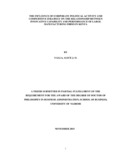| dc.description.abstract | Recent studies have examined innovative capabilities and discussed their impact on firm
performance. However, the studies have ignored the external political operating
environment. This study extended the innovative capability stream of research and
examined how corporate political activity and competitive strategy influence the
relationship between innovative capability (internal learning processes, technological
innovation, and research and development intensity and employee development) and
performance (financial performance, customer satisfaction, process performance and
employee satisfaction) of large manufacturing firms in Kenya. The study had five
objectives. The research design was cross sectional. Empirical data was collected from
one hundred and twenty nine firms listed in the Directory of Kenya Association of
Manufacturers. Evidence was found of positive systematic innovative
capability/corporate political activity/competitive strategy/ performance relationship. As
anticipated, innovative capability had a positive influence on performance. Corporate
political activity was found to have a strong influence on the relationship between
innovative capability and performance. Counter to expectation, industry alliances did not
have a significant effect on firm performance. These findings are consistent with
theoretical assertions and prior research which show that interaction between internal and
external resources impact performance. Specifically, the study revealed that research and
development intensity, public/government alliances and cost leadership strategy are
important moderators in the relationship between innovative capability and performance.
Contrary to expectations, the strength of the influence of competitive strategy on the
relationship between innovative capability and performance though positive was weak.
However, the joint effect of innovative capability and competitive strategy on
performance was slightly greater than the individual effect of innovative capability. The
findings suggest that integration of corporate political activity and competitive strategy
on the interaction between innovative capability and performance enhances the outcome.
Indeed, the empirical analysis suggests that in order to allow innovative efforts to be
significant, huge investments have to be made in research and development and the
strengthening of public/government alliances. It is concluded that in order to maintain
superior performance firms should effectively integrate corporate political activity into
their innovative capability and competitive strategies. The study experienced limitations
in terms of use of questionnaires only, which are sometimes subject to reporting
inaccuracies. Further research recommended that other moderating variables be included
in future studies, to further establish additional factors that influence the relationship
between innovative capability and performance. The findings and conclusions of the
study were discussed in view of implications on theory, policy and practice. On
theoretical implications, the study was able to support and extend arguments by resource
based view, dynamic capabilities and theories on innovation that firms should
continuously evaluate the sustainability of their positions by understanding their market
positions from their dynamic core competencies. In terms of policy, the study highlights
the need for closer collaboration between government and key stakeholders in the
manufacturing sector to increase the sectors competitiveness. For managers the study
underscores the need to develop managerial capabilities to effectively manage factors in
the firm’s external operating environment. | en_US |

